Nandini D
Everyone wishes to be happy and healthy. Gardening is a simple way of achieving both health and happiness. It can be taken up by anyone at any age. Gardening enhances awareness of one’s surroundings, improves cognitive skills and provides an opportunity to appreciate nature, especially since most of us live in urban jungles. While eco-clubs and nutrition gardens are slowly making their way into schools, many are still unaware of the benefits of gardening. Therefore, Teacher Plus brings you a monthly column on gardening. Articles in this column will provide information about common plants and their use in daily life. Each article will focus on a set of activities and provide a broader scope for learning.
When the bell rang, I went to see who was at the door. Anand and Vivan entered. They came to show the butterfly pictures they had clicked.
I looked at the pictures and appreciated them.
“You know, there is a Butterfly Garden in Bannerghatta Park. Can we also make such a garden, aunty?” Vivan asked.
“We can grow plants which attract butterflies. However, you know that a butterfly comes from a cocoon and before that it was a caterpillar, and the caterpillar from an egg. We need to create a shelter for all these,” I replied.
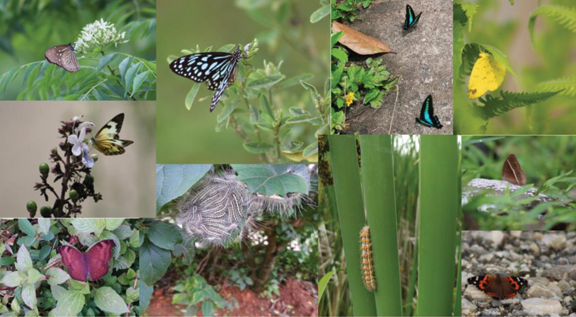
“I know, the butterfly life cycle is mentioned in my science book. Let me know, what should be there to attract butterflies, so that we can try,” Anand said.
“We must grow native flowering plants because the plants and butterflies are evolving together.”
I tried to explain, “The flowers should be colourful with a sweet smell. Also, butterflies should be able to get nectar and pollen. Butterflies need to spread their wings in the sun and rest, by that they get the energy to fly again. They often perch on stones, soil or even on leaves. Butterflies gather on marshy areas to get the minerals they need. They lay eggs only if the caterpillars can feed on them.”
“If we grow flowers which give nectar, then honeybees will also come?” Vivan asked.
“Yes, dear, that is how beekeepers install boxes in gardens. So that they can regularly collect the honey.”
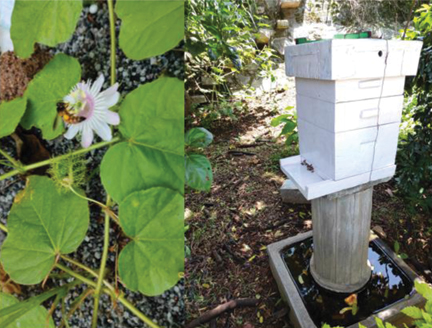
Vivan exclaimed, “I noticed a butterfly sitting on an Aloevera flower. I used my cell phone to take a photograph. This is the first time I noticed beautiful flowers on this plant; it attracts butterflies also!”
“Vivan, if you wish to attract birds, butterflies, better not to use any chemical fertilizer or sprays in the garden.”
I noticed a message from Madhavi. She sent a photo with a caption, ‘assignment done.’ I could not control my laughter.
“What made you to laugh, aunty? Show me,” Vivan looked at my phone.

“See, Madhavi aunty is quick, she made this water server and sent the picture.” I showed the picture to the children.
“We are going to her house tomorrow. Shilpa’s birthday party is in the evening. You are also invited,” Anand reminded me.
I started thinking about a gift for Shilpa. “What is the best present I can give her – a book, showpiece or plant?”
Suddenly I remembered, a terrarium. As it was not ready, I started checking my collection and found an empty glass jar and pebbles.
I said, “I will prepare a terrarium for Shilpa. She can keep it on her table or on a window sill.”
“What is this terrarium? You make it now. We will also learn to do it,” the children said.
“Ok, children, you spread everything outside and sit. I will clean this jar and bring it.”
To make a terrarium
Take an empty glass jar
• Add pebbles/ granules up to 1 inch in the jar.
• Spread a thin layer of charcoal over the pebbles to avoid fungal growth.
• Spread a layer of sand over it, about 1½ inch.
• Add 2-3 inches of potting mixture over it.
• Place small plants in the centre and creative elements like a doll or an umbrella around it.
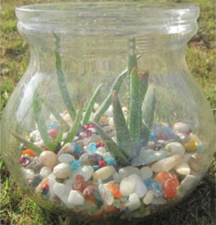
“This looks beautiful. How to water this?” Vivan asked.
“Just sprinkle water once in two days, if you pour too much, it gets spoiled,” I replied.
“How long can we keep this?” Anand asked.
“You can keep it 2-3 months, when it grows big, take it out and plant it outside,” I said.
Vivan said, “Good idea. Instead of keeping a flower vase and changing flowers and water every day, we can do this.”
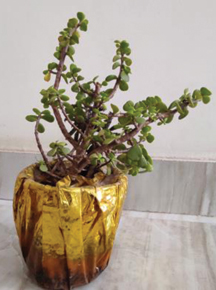
The next day we all gathered at Shilpa’s house to celebrate her birthday. Everyone wished her and handed over the gift they carried. Anand gave her a jade plant. He wrapped the pot with a gold coloured foil. He said, “See this is the plant which survived in the summer, though no one was there to water plants at home.”
Sujatha said, “Even Malabar spinach, which is very soft dried up in the summer. But I see young plants after the rain. Salvia is also growing again.”
I said, “Plants shed seeds, so these plants start growing again when they get the suitable condition. Similarly, plants with bulbs like lily and dahlia start coming up after the rains.”
“As I was not there at home during the lockdown, even in my home, giloy dried up completely. The stem was tightly woven to the grills, so I could not remove it. To my surprise it started showing green leaves when I regularly watered the plants. Thank God, nature is always with us to support.”
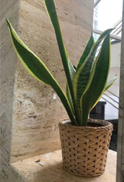
Vivan gave a Snake plant (Sansevieria) in a cane basket. Shilpa kept all the plants in different corners of her house.
Rina and Sujatha presented a beautiful paper file decorated with dried flower petals and leaves.
“It is beautiful, how did you make it?” Vivan asked.
‘I collected petals and leaves and dried them between papers. Later, I took them out to see what best design I could make. You can find fern leaves also in this. I made some greeting cards too,” Rina replied.
“Everyone’s gifts are very creative! Nandini, what kinds of plants can we use to make a terrarium?” Madhavi asked.
“Preferably succulents, which require less water like Aloevera, Sanseveria, stone crop (Sedum), jade plant. These plants survive in shade also and are good as indoor plants.”
“Now all of you come with me to our terrace; I want to show you something.” Shilpa asked everyone to follow her.
“This is my water pond with lilies and fish.” Shilpa pointed at the water basin with pride.
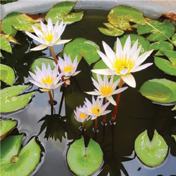
“Beautiful,” everyone screamed.
“Do not make noise, the fish will hide under the water and you cannot see them. They are very sensitive,” Paati instructed.
“Now I will show my collection, by the time Madhavi will get drinks and snacks for everyone.”
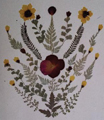
“See, I am collecting seeds and fruits. So that I can have my own stock for the next season,” Paati spread her seed collection.
“Can we save seeds from vegetables, which we buy from the market, paati?” Anand asked.
“You can try, Anand, instead of discarding keep a few, properly dry them and sow them after some time. At least some of them will come up,” I replied.
Paati said, “I wish to grow vegetables. Tomato, capsicum, chilly come up very easily. Growing chayote (squash) and flat beans is not difficult. Climbers do not need much maintenance. But we do not have land, what to do? It is too hot on this open terrace, difficult for plants.”
Madhavi brought juice and snacks. Shilpa started serving.
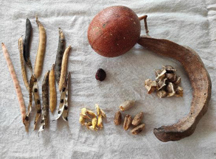
Madhavi said, “We can visit Uma’s house. She has a terrace garden. Then we can go to a nearby nursery and check. So that we can get an idea on how we can utilize the available space, and what plants we can grow.”
“We can plan our own garden design, Madhavi. Henceforth, we will save seeds and try,” Sujatha added.
Find the answers
- Identify the flowers, which attract butterflies and bees around your house.
- What kind of artifacts can you prepare from plant materials?
Bibliography
- Ganesh Babu and Nandini D 2016, I love my Herbal Garden, FRLHT, Bengaluru
- Radha Eswar, Ganesh Babu et al., 2016, Herbal Gardening Heals, FRLHT, Bengaluru
- https://blog.fantasticgardeners.co.uk/start-butterfly-garden/
- https://www.homeobook.com/doctrine-of-signature-a-source-of-homoeopathic-materia-medica/
- https://www.ahta.org/horticultural-therapy
The author is a botanist. She has been involved in teaching and research for more than 25 years. Currently she is working as a consultant for We Care Society (WCS), Bengaluru and is visiting faculty RIWATCH, Roing, Arunachal Pradesh. She can be reached at nandinidholepat@gamil.com.
